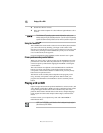
4
Setting up your computer and getting started
RG 5.375 x 8.375 ver 2.3.4
HINT: This icon denotes helpful hints and tips.
DEFINITION: This icon indicates the definition of a term used in the text.
Other documentation
Your computer comes with all or some of the following documentation in
addition to this resource guide:
❖ Electronic user’s guide installed on your system.
❖ Guides for other software that may come preinstalled.
❖ Microsoft
®
Windows
®
XP operating system documentation.
❖ For accessory information, visit Toshiba’s Web site at toshiba.com.
❖ The Recovery Media containing the programs that are preinstalled at
the factory and any bundled software. Keep this media in a safe and
convenient place.
Setting up your computer and getting started
Strain and stress injuries are becoming more common as people spend
more time using their computers. With a little care and proper use of the
equipment, you can work comfortably throughout the day.
Using the computer keyboard incorrectly can result in discomfort and
possible injury. If your hands, wrists, and/or arms bother you while typing,
stop using the computer and rest. If the discomfort persists, consult a
physician.
For more information, consult books on ergonomics, repetitive-strain
injury, and repetitive-stress syndrome.
Placement of the computer
Proper placement of the computer and external devices is important to
avoid stress-related injuries. Consider the following when placing your
computer.
❖ Place the computer on a flat surface at a comfortable height and
distance. You should be able to type without twisting your torso or
neck, and look at the screen without slouching.
❖ If you are using an external monitor, the top of the display should be
no higher than eye level.
❖ If you use a paper holder, set it at about the same height and distance
as the screen.


















